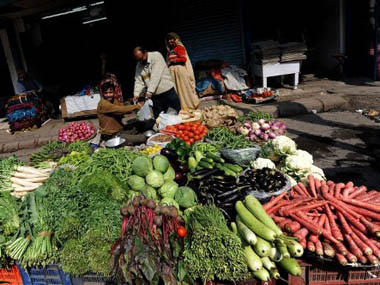Retail inflation increased to 4.62 percent in October, breaching the Reserve Bank’s medium-term target of 4 percent for the first time in 16 months, mainly on account of higher food prices, according to government data released on Wednesday. The inflation rise above the 4 percent level has reduced the headroom for a rate cut by the RBI in its monetary policy due next month. The inflation based on Consumer Price Index (CPI) was 3.99 percent in September and 3.38 percent in October 2018.
October CPI at 4.62%, #CPI core inflation at 3.5% Vs 4% (MoM)#inflation #CPI #OctoberCPI #OctCPI #CPIData #macros #macrodata #economicdata pic.twitter.com/BwTL7QgVZG
— CNBC-TV18 (@CNBCTV18Live) November 13, 2019
The earlier high was reported in June 2018 when the retail inflation print was recorded at 4.92 percent. The inflation in the food basket spiked to 7.89 percent in October 2019 as against 5.11 percent the preceding month. Vegetable inflation also increased 26 percent in October compared with 15.4 percent in September. [caption id=“attachment_587204” align=“alignleft” width=“380”] Representational image. AFP[/caption] Likewise, the prices of cereals, meat and fish, eggs grew at faster pace of 2.16 percent, 9.75 percent and 6.26 percent, respectively. For pulses and related products, retail inflation rose to 11.72 percent. However, the prices of fuel and light category continued to witness downward move at (-) 2.02 per cent as against (-) 2.18 per cent a month earlier, showed the data. The Reserve Bank of India (RBI) mainly factors in the CPI-based inflation to arrive at its bi-monthly monetary policy. Aditi Nayar, economist at Icra said, looking ahead the pace of normalisation in vegetable prices will be the key driver of the trend in food inflation over the next few months. “Overall, the CPI inflation may continue to print higher than 4 per cent in the remainder of FY2020, complicating policy choices in light of the slowdown in economic growth momentum. “The sharp uptick in the CPI inflation in October 2019 has contrasted with the industrial contraction recorded in September 2019. In our view, the extent to which the Q2 FY2020 GDP growth reading eases further from the 5 percent recorded in the previous quarter, will influence the MPC’s decision on whether to cut rates further, and by how much, in the December 2019 policy review,” she said. Rahul Gupta, head of currency, Emkay Global Financial Services, said this sharp rise was especially due to uptick in food prices amid erratic monsoon. “Despite rising inflation, we expect (the) RBI to continue its easing cycle on the back of sluggish growth and weak core inflation and cut repo rate at December meeting,” Gupta said. The RBI has been asked to keep the retail inflation at around 4 percent.
Retail inflation probably exceeded the RBI’s medium-term target of 4 percent in October for the first time in 15 months, mainly because of rising vegetable prices, a Reuters poll of economists showed. Prices of most vegetables climbed during the month as monsoon downpours delayed harvests and disrupted supplies. That was despite a government ban on onion exports, a key component in the Indian diet. Overall food prices—the biggest chunk of the consumer price basket —also rose in October. The 4-7 November Reuters poll of 39 economists forecast annual consumer price inflation to rise to 4.25 percent in October, its highest since June 2018 and above 3.99 percent in September. Nearly 85 percent of respondents forecast retail inflation, due on 12 November, to breach the RBI’s medium-term target. “Vegetable prices, particularly that of onions and tomatoes, will contribute significantly to the rise in inflation,” said Teresa John, an economist at Nirmal Bang, a retail brokerage.
“We expect the RBI to maintain its easing bias on the back of sluggish growth and weak core inflation pressures despite rising headline inflation led by food prices.” With the inflation level remained the sub-4 percent level, the RBI has cut its key interest rate by a cumulative 135 basis points this year to 5.15 percent. The central bank is expected to cut the repo rate in December for the sixth meeting in a row, according to a separate Reuters poll. That view primarily stems from a slowing economy. —With inputs from agencies


)

)
)
)
)
)
)
)
)



